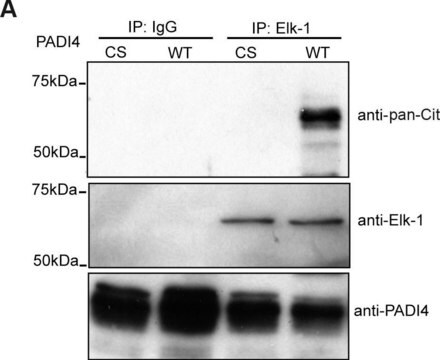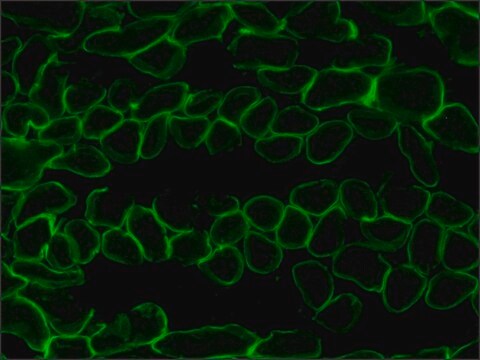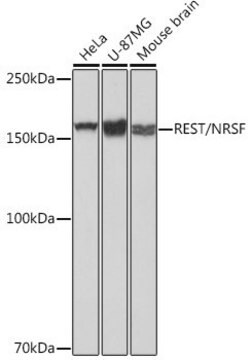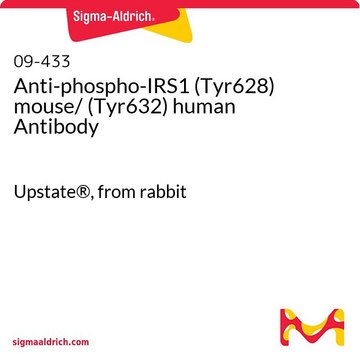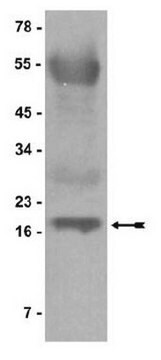추천 제품
생물학적 소스
mouse
Quality Level
항체 형태
affinity purified immunoglobulin
항체 생산 유형
primary antibodies
클론
16A, monoclonal
종 반응성
rat, human
제조업체/상표
Chemicon®
기술
immunocytochemistry: suitable
immunohistochemistry: suitable
western blot: suitable
동형
IgG1
NCBI 수납 번호
UniProt 수납 번호
배송 상태
wet ice
타겟 번역 후 변형
unmodified
유전자 정보
human ... CDH11(1009)
일반 설명
Cadherins constitute a family of transmembrane glycoproteins involved in Ca2+-dependent cell-cell interactions. The members of this family are differentially expressed in various tissues. They function in the maintenance of tissue integrity and morphogenesis. The cadherins generally contain five extracellular repeats, a transmembrane domain and a cytoplasmic tail that binds to the catenin family of cytoskeletal anchoring proteins which also function as signal transducers. The extracellular domains are responsible for the specificity of homophilic interactions between cells expressing the same cadherin. Cadherins are divided into type I and type II subgroups. Type I cadherins include epithelial cadherin (E-cadherin, cadherin-1 or uvomorulin), neural cadherin (N-cadherin or cadherin-2), placental cadherin (P-cadherin or cadherin-3) and retinal cadherin (R-cadherin or cadherin-4). Kidney cadherin (K-cadherin or cadherin-6) and osteoblast cadherin (OB-cadherin or cadherin-11) are type II cadherins. The progression of carcinomas is associated with the loss of epithelial morphology and a concomitant acquisition of a more mesenchymal phenotype, which is thought to contribute to the invasive and/or metastatic behavior. A putative role for cadherin-11 in these late stages of tumor progression is based on the fact that migration of mesenchymal cells is facilitated when cadherin-11 is highly expressed.
특이성
Reacts with the extracellular domain of human cadherin-11.
면역원
Epitope: extracellular domain
Fusion protein corresponding to extracellular domain of human OB-cadherin coupled to GST.
애플리케이션
Detect OB-Cadherin using this Anti-OB-Cadherin Antibody, extracellular domain, clone 16A validated for use in WB, IC, IH.
Research Category
Cell Structure
Cell Structure
Research Sub Category
Adhesion (CAMs)
Adhesion (CAMs)
Western blot: 1:25 - 1:250
Immunohistochemistry: Frozen tissue sections. 1:25 - 1:50 dilution using avidin-biotinylated horseradish peroxidase complex (ABC) as detection protocol.
Immunocytochemistry: Methanol and paraformaldehyde-fixed cells
Optimal working dilutions must be determined by the end user.I/
Immunohistochemistry: Frozen tissue sections. 1:25 - 1:50 dilution using avidin-biotinylated horseradish peroxidase complex (ABC) as detection protocol.
Immunocytochemistry: Methanol and paraformaldehyde-fixed cells
Optimal working dilutions must be determined by the end user.I/
물리적 형태
Affinity purified immuoglobulin. Liquid in PBS containing 0.09% sodium azide.
Format: Purified
저장 및 안정성
1 year at 4°C from date of shipment
기타 정보
Concentration: Please refer to the Certificate of Analysis for the lot-specific concentration.
법적 정보
CHEMICON is a registered trademark of Merck KGaA, Darmstadt, Germany
면책조항
Unless otherwise stated in our catalog or other company documentation accompanying the product(s), our products are intended for research use only and are not to be used for any other purpose, which includes but is not limited to, unauthorized commercial uses, in vitro diagnostic uses, ex vivo or in vivo therapeutic uses or any type of consumption or application to humans or animals.
적합한 제품을 찾을 수 없으신가요?
당사의 제품 선택기 도구.을(를) 시도해 보세요.
Storage Class Code
12 - Non Combustible Liquids
WGK
WGK 2
Flash Point (°F)
Not applicable
Flash Point (°C)
Not applicable
시험 성적서(COA)
제품의 로트/배치 번호를 입력하여 시험 성적서(COA)을 검색하십시오. 로트 및 배치 번호는 제품 라벨에 있는 ‘로트’ 또는 ‘배치’라는 용어 뒤에서 찾을 수 있습니다.
Ziqiang Teo et al.
Scientific reports, 7(1), 6303-6303 (2017-07-26)
In adult skin wounds, collagen expression rapidly re-establishes the skin barrier, although the resultant scar is aesthetically and functionally inferior to unwounded tissue. Although TGFβ signaling and fibroblasts are known to be responsible for scar-associated collagen production, there are currently
Sook Kyung Chang et al.
The Journal of clinical investigation, 127(9), 3300-3312 (2017-08-02)
M2 macrophages, innate lymphoid type 2 cells (ILC2s), eosinophils, Tregs, and invariant NK T cells (iNKT cells) all help to control adipose tissue inflammation, while M1 macrophages, TNF, and other inflammatory cytokines drive inflammation and insulin resistance in obesity. Stromal
자사의 과학자팀은 생명 과학, 재료 과학, 화학 합성, 크로마토그래피, 분석 및 기타 많은 영역을 포함한 모든 과학 분야에 경험이 있습니다..
고객지원팀으로 연락바랍니다.